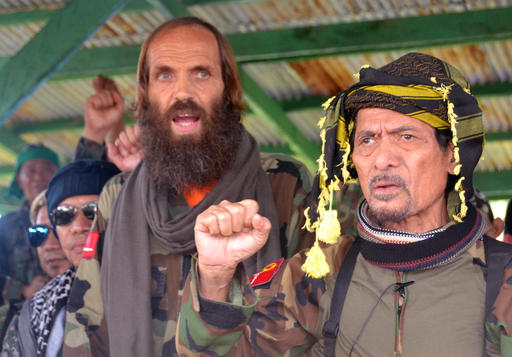Money and Misuari

Released Norwegian hostage Kjartan Sekkingstad, second right, stands next to Moro National Liberation Front Chairman Nur Misuari, right, after being turned over by ransom-seeking Abu Sayyaf extremists in Indanan township on Jolo island in southern Philippines Sunday, Sept. 18, 2016. Sekkingstad, who was kidnapped last year along with two Canadians and a Filipino, was released Saturday and was turned over Sunday to Misuari, who in turn turned him over to Presidential adviser Jesus Dureza. AP FILE PHOTO
THAT NORWEGIAN hostage Kjartan Sekkingstad has regained his freedom is cause for cheer. His harrowing experience at the hands of the bandit group Abu Sayyaf—which had kidnapped him in September 2015 in Samal, Davao, along with Filipino Marites Flor and Canadians Robert Hall and John Ridsdel—was unmistakably etched on his gaunt, frail appearance when he was first seen after his release.
What he went through in his yearlong captivity was “devastating,” said Sekkingstad. “We were treated like slaves”—subjected to constant threats of beheading, forced to lug around the bandits’ belongings as they were hustled from one area of Sulu to another to evade military operations, and generally kept in a state of terror and bewilderment over their fate. He also witnessed something unspeakable—the beheading of Ridsdel and Hall, whose grisly deaths were even recorded and posted online by the Abu Sayyaf.
Article continues after this advertisementThat the Norwegian didn’t suffer the same horrific fate is reportedly because P100 million was paid for his release—not by the Philippine government, but by his family and friends in Norway. President Duterte himself let slip a month ago that some P50 million had been paid to the bandits for the release of their captives; in the wake of Sekkingstad’s freedom, that admission was nowhere mentioned in the statement of the Palace, which merely reiterated the official position that “the government maintains the no-ransom policy.”
But, “if a third party or the family gives ransom, we don’t know,” said Presidential Communications Secretary Martin Andanar—a disclaimer issued straight-faced despite Mr. Duterte publicly disclosing, however inadvertently, that he did know about ransom being paid early on. So while Sekkingstad’s release is a much welcome development, the circumstances surrounding it beg for some answers about the administration’s stance toward the Abu Sayyaf—and, just as crucial, about the people with whom the administration is willing to work in order to secure the kidnap victims’ freedom.
The other startling news about Sekkingstad has to do with the person who received him after he was released: Nur Misuari, head of the Moro National Liberation Front. The President personally thanked Misuari for his role in securing Sekkingstad’s release, but the narrative isn’t as cut-and-dried as it seems. Misuari apparently wanted to milk the event for the favorable mileage it could give him. It is said that after receiving Sekkingstad, Misuari delayed his release to the authorities, keeping the Norwegian in his base in Patikul because he wanted to personally deliver the freed captive to the President—or, failing that, at least make an appearance at the airport in Jolo where media cameras would capture him as the helpful local overlord instrumental in obtaining the prisoner’s freedom.
Article continues after this advertisementMisuari, it should be said, remains the object of an outstanding warrant of arrest for instigating the 2013 siege of Zamboanga City, which left at least 300 people dead, over 120,000 residents displaced, and vast tracts of property damaged. Misuari fled to and lived as a fugitive in Malaysia, but in January he slipped back into the country, reportedly to lead a general assembly of the MNLF in Sulu that was attended by some 2,000 of its members. That sense of impunity was further strengthened when Mr. Duterte came to power in June and forthwith ordered a stop to the pursuit of Misuari so peace talks could be held between the government and the MNLF.
Misuari’s role in Sekkingstad’s release, whatever it is, further solidifies his rehabilitation in this administration’s eyes; he’s relevant again and, given his behavior following the Norwegian’s release, apparently hasn’t lost his yearning for the limelight. And Mr. Duterte’s administration appears willing to indulge him. Presidential Peace Adviser Jesus Dureza made no mention of Misuari’s behavior and blamed bad weather for the delay in Sekkingstad’s presentation to the President, his waiting kin, and the Norwegian ambassador in Davao.
Three Indonesian fishermen held by the Abu Sayyaf were also released at about the same time as Sekkingstad. The military said it was the result of intensified operations against the group. But reports said ransom was, as usual, paid—an unspecified amount, but no doubt significant enough to empower this band of thugs to commit more acts of terror.















